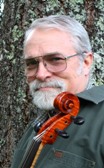
Introductions are in Order:
Hi! I’m Chet Bishop, the luthier in this shop. I am also the owner, bookkeeper, webmaster (riiiight!), purchaser of materials, shipper, sales representative and janitor. In other words, I am operating as a sole-proprietorship, run pretty much by just me. I build and repair violin-family instruments, as well as purchasing all the materials and supplies.
When there are customers to talk to, I serve as the “public relations guy.” When there are shavings on the floor, or a spill to clean up, I’m the janitor. (Gotta do it right away, too, or Ann will step in and do it for me. She is only trying to be helpful, but it shames me, because I see it as my job.)
It has taken me years to learn how to do it, but I build all our websites, too. (Fortunately, the support staff at my webhosting company have shown great patience. I have had to ask for help pretty frequently.)
The Beginning:
I began building acoustic, violin-family instruments in 1999, because my youngest son needed a viola, and I was just sure that “the stores were charging too much.” (They were not, most likely, but my indignation at the perceived “gouging” drove me to build my first instrument.) By the time I finished that viola (almost two years later) I was hooked, and the rest is history.
I wanted to learn more, but at my age (45, at the time), it was not possible to just drop everything and run off to school, somewhere. So, I bought 70 old, broken, or neglected violins on eBay. I bought some factory seconds, and some “violin-shaped objects.” (I really had no idea what was good or bad, yet.)
I bought books, searched online, and joined forum after forum, to absorb whatever information was available, wherever I could find it.
Learning:
Jake Jelley, a violin-maker friend, told me of various workshops: Ann and I eventually decided that I should take a week or so off work. (Surely that short a time would not break the family budget.) So, I drove to places like Tucson, AZ, and Claremont, CA, as well as closer places like Murphy, OR. (I live about 45 minutes west of Portland, OR.) Each teacher had something to offer. (None of them made five-string fiddles. That was a later “revelation.”)
With every instrument I made, my goal was to eliminate all the known mistakes or flaws in the previous instruments. As a result, with one possible exception, each new instrument has truly been “the best I have built, so far.” I attend shows and I sell to people at those shows, as well as to those who find me online. Players have responded more and more positively, over the years. I am grateful for that growth, too.
I really enjoy repairing and building instruments of the violin-family. So far, I have built violin, viola, cello, and double bass. I began building the acoustic five-string variants of each, as a later addition. (For now, I do not intend to build electric instruments.)
Lutherie is therapeutic and very satisfying. One sees the beauty of the wood itself, to begin with, and then sees it transformed from a raw chunk of wood to a beautiful instrument. That instrument may last for centuries (some have, for sure.) The whole experience is a real joy to me.
The Materials:
I have a large “stash” of domestic wood: heavily flamed Big Leaf maple, which I obtained when a fellow gave me an entire log, some years ago. (See the story here.) For my orchestral instruments, I purchase European maple and spruce, as that is the preferred (and expected) combination for traditional violins. But there is more flexibility on violas and cellos, and, especially, on double basses, as tradition is a little more forgiving on the larger instruments.
Tradition-Free!
But Five-String Instruments are not bound by tradition, so I can use whatever works well, and I feel free to do so. There are combinations I would not try, because my experience tells me they would not work…but I am free to try new things because no traditionalist will speak up, and say, “Oh, no, you have to use Italian wood!” Hence, I may use cherry, apple, exotic woods like bubinga, local specialties, like Myrtle, or a host of others. (See examples, here.)
I have had to come up with my own design changes, as very few luthiers have taken the plunge into acoustic five-string territory; so I have to use what I know of acoustics, and stress, and try to apply it to the new instrument. The results have been very satisfying. I get a good, clear, powerful C-string sound on a violin-sized instrument, and a good E-string on the same instrument.
Pressing On
I have continued to do repairs, as the need arises. I’ve done every sort of repair imaginable, except re-arching. The “restorations” I have done have turned out well, but when I see the work of fellows who can restore an instrument which has been run over by a car, I just shake my head: I know my limitations. However, I have gotten good results, in virtually all cases; partly because I try to treat each instrument I repair as if it is a priceless heirloom. You see, to the owner, that is exactly what it is: irreplacable.
If you have a need I can address, please feel free to give me a call.
